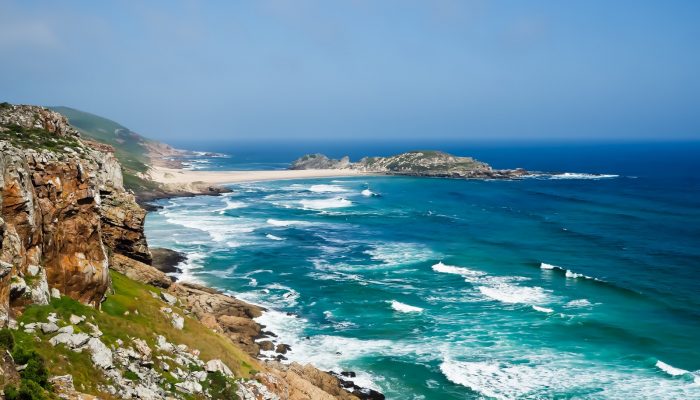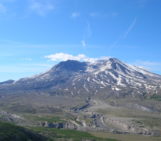
This picture is taken from the Robberg Peninsula, one of the most beautiful places, and definitely one of my favorite places in South Africa. The Peninsula forms the Robberg Nature Reserve and is situated close to the Plettenberg Bay on the picturesque Garden Route. “Rob” in Dutch means “seal”, so the name of the Peninsula is translated as “the seal mountain”. This name was given to the landmark by the early Dutch mariners, who observed large colonies of these noisy and restless animals on the rocky cliffs of the Peninsula. Seals still inhabit this area today.
The Peninsula is constituted of two rocky parts, rising above the sea level at about 150 m, and which are separated from each other by the “Gap” – a low and narrow sandy neck. The length of the Peninsula is about 4 km and the width is up to 750 m, which narrows down to 200 m at the “Gap”. The eastern rocky part forms an extension to the south – another tiny peninsula, “the Island” (on the picture). “The Island” is a small rocky area connected with the main Peninsula by a narrow strip of sand. This sand bar is essentially a beach washed by water at its both long sides. With “the Island” the entire Peninsula has a shape of a mitten, which thumb is looking down.
Robberg Island is entirely built up by the sedimentary rocks: quartzites of the Table Mountain Group (part of the Cape Supergroup), and Robberg’s Formation sandstones, conglomerates and breccias. Table Mountain Group is formed some 500-330 million years ago; and the Robberg’s formation, which is the part of the Uitenhage Group, is around 120 million years old and related to Gondwana break-down. Upper parts of the Peninsula are covered by the Quaternary dune deposits. At the moment the rocks of Robberg Peninsula are actively eroded by the Indian Ocean waters.
Robberg Peninsula is a beautiful home of many marine bird species, small reptiles, seals and indigenous plants. The Nelson Bay Cave, situated on the Robberg Peninsula, is one of the oldest caves, inhabited by human. It was occupied from 120 000 years ago, by various tribes, including San and Khoikhoi people. Nelson Bay Cave was formed due to the erosion caused by the ocean waves.
Description by Elizaveta Kovaleva, post-doctoral researcher at University of the Free State, in South Africa
If you pre-register for the 2018 General Assembly (Vienna, 08–13 April), you can take part in our annual photo competition! From 15 January until 15 February, every participant pre-registered for the General Assembly can submit up three original photos and one moving image related to the Earth, planetary, and space sciences in competition for free registration to next year’s General Assembly! These can include fantastic field photos, a stunning shot of your favourite thin section, what you’ve captured out on holiday or under the electron microscope – if it’s geoscientific, it fits the bill. Find out more about how to take part at http://imaggeo.egu.eu/photo-contest/information/.
Imaggeo is the EGU’s online open access geosciences image repository. All geoscientists (and others) can submit their photographs and videos to this repository and, since it is open access, these images can be used for free by scientists for their presentations or publications, by educators and the general public, and some images can even be used freely for commercial purposes. Photographers also retain full rights of use, as Imaggeo images are licensed and distributed by the EGU under a Creative Commons licence. Submit your photos at http://imaggeo.egu.eu/upload/.




